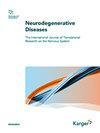Is 123I-MIBG Scintigraphy Beneficial or Excessive for the Diagnosis of Parkinson’s Disease in the Early Phase?
IF 1.9
4区 医学
Q3 CLINICAL NEUROLOGY
引用次数: 4
Abstract
Introduction/Objective: In most cases, abnormal cardiac 123I-meta-iodobenzylguanidine (MIBG) scintigraphy increases the probability of a diagnosis of Parkinson’s disease (PD) in patients with parkinsonian features. In our study, we validated the additional value of 123I-MIBG scintigraphy beyond providing information on neurological findings and response to dopaminergic therapy for the diagnosis of PDin the early phase. Methods: We investigated 77 cases of PD (Hoehn and Yahr Stages I–III) and 73 cases of atypical parkinsonian disorder (APD), including 35 patients with multiple system atrophy, 19 with corticobasal syndrome, and 19 with progressive supranuclear palsy. Two multiple logistic regression models were developed to predict the probability of PD based on APD. Common covariates were resting tremor, vertical supranuclear palsy, apraxia, cerebellar symptoms, and response to dopaminergic therapy with MIBG scintigraphy (reference model) or without it (MIBG-added model). The net reclassification index (NRI) was examined and net benefit using decision curve analysis was performed to examine the additional clinical value of MIBG scintigraphy. Finally, we estimated the cost-effectiveness of MIBG scintigraphy. Results: The MIBG-added model significantly improved the ability to classify PD or APD compared with the reference model (NRI index 1.390, p < 0.001). However, the decision curve of the reference model ranked equally with the MIBG-added model up to a risk threshold of 0.8. In addition, MIBG scintigraphy was not cost-effective. Conclusions: Although MIBG scintigraphy has statistical usefulness for PD diagnosis, there may be little additional benefit in the early phase of PD beyond the neurological findings and response to dopaminergic therapy regarding clinical effectiveness and cost-effectiveness. It may be of greatest value when neurological findings that do not match PD are observed during the clinical course.123I-MIBG闪烁扫描术对早期帕金森病的诊断是有益的还是过度的?
引言/目的:在大多数情况下,心脏123I间碘苄基胍(MIBG)闪烁扫描异常会增加帕金森病特征患者诊断为帕金森病(PD)的概率。在我们的研究中,我们验证了123I-MIBG闪烁扫描除了提供神经系统发现和多巴胺能治疗反应的信息外,在早期诊断PD的额外价值。方法:我们调查了77例帕金森病(Hoehn和Yahr I–III期)和73例非典型帕金森病(APD),包括35例多系统萎缩患者、19例皮质基底综合征患者和19例进行性核上性麻痹患者。基于APD建立了两个多元逻辑回归模型来预测PD的概率。常见的协变量是静息性震颤、垂直性核上性麻痹、失用症、小脑症状,以及使用MIBG闪烁扫描(参考模型)或不使用MIBG(添加MIBG的模型)对多巴胺能治疗的反应。检查净再分类指数(NRI),并使用决策曲线分析进行净收益,以检查MIBG闪烁扫描的额外临床价值。最后,我们估计了MIBG闪烁扫描的成本效益。结果:与参考模型相比,添加MIBG的模型显著提高了对PD或APD的分类能力(NRI指数1.390,p<0.001)。然而,参考模型的决策曲线与添加MIBG模型排名相同,风险阈值为0.8。此外,MIBG闪烁扫描不具有成本效益。结论:尽管MIBG闪烁扫描对帕金森病的诊断具有统计学意义,但在帕金森病的早期阶段,除了神经系统发现和多巴胺能治疗的反应外,在临床有效性和成本效益方面,可能没有什么额外的益处。当在临床过程中观察到与PD不匹配的神经系统发现时,这可能具有最大价值。
本文章由计算机程序翻译,如有差异,请以英文原文为准。
求助全文
约1分钟内获得全文
求助全文
来源期刊

Neurodegenerative Diseases
医学-临床神经学
CiteScore
5.90
自引率
0.00%
发文量
14
审稿时长
6-12 weeks
期刊介绍:
''Neurodegenerative Diseases'' is a bimonthly, multidisciplinary journal for the publication of advances in the understanding of neurodegenerative diseases, including Alzheimer''s disease, Parkinson''s disease, amyotrophic lateral sclerosis, Huntington''s disease and related neurological and psychiatric disorders.
 求助内容:
求助内容: 应助结果提醒方式:
应助结果提醒方式:


